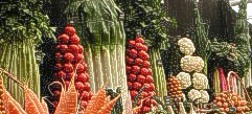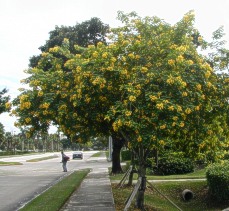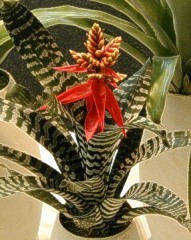
Allergy-Aware Gardens
by Derek Burch
Allergy sufferers come in all sizes and shapes, as do the variety of things
to which they are susceptible and the severity of the attacks.
One thing is certain, however, and that is the good sense of avoiding exposure to the allergen as far as this is possible. Even with the effective medicines now coming onto the market, it is bound to be better to limit contact with problem materials.
Many of the probable culprits inside houses and offices are well known, and appropriate techniques for avoidance can be applied, although these often involve a major change in lifestyle. Is the same level of avoidance possible outside the house? It may not be, without measures so extreme as to be like living inside a bubble, but there are a few simple steps that can be taken.
What is possible, is to recognise probable allergenic plants, whether they are the actual plants which testing has shown to be at the root of an individual's problem or those which produce pollen or other substances that have the potential to cause a problem.
There is little that the individual can do when these plants are in natural or weedy areas, or in public landscaping (give up shopping at malls where the parking lots have trees that produce allergenic pollen? Hardly likely!) But in the home garden it should be relatively easy to avoid exposure by banishing plants that are likely to be troublesome.
Listing the broad categories of plants with pollens that are likely to cause respiratory problems is fairly easy. They will be plants whose pollen is distributed by wind rather than by some animal carrier. This usually means that the flowers will be tiny and not individually conspicuous although there will also probably be a great many of them, and together they may be quite showy.
If they are trees or shrubs they probably produce the flowers when they have no leaves. (Quite logical, really: the plants do not need to spend the energy to build individually attractive flowers to signal to their pollinators since the wind cannot read signals, and producing the flowers on bare branches allows the pollen to move on any breeze without leaves getting in the way.) Fragrance is unlikely unless some of the pollination is also done by insects.
For grasses and other weeds, look for problems with small flowers carried well above the foliage. Be very suspicious of plants in the daisy family that are not showy, and of the ornamental relatives of pigweed (amaranthus) and spinach. Stinging nettle is not only unpleasant to touch, but has wind-borne pollen which is allergenic for many people. Grasses and these other weeds will be producing pollen from late spring through fall.
What is likely to be safe? First bear in mind that each of us is unique in our genetic makeup, and hence our response to all factors of our environment. In theory anyone could become sensitised to almost anything. Our response to materials foreign to the body can also change with time, so it is impossible to make any guarantees that any plant will be safe for everyone for ever. It is wise to approach any lists of safe plants with the knowledge that the plants named have given very little reason to suspect that they will cause any problems, but could possibly have hidden dangers for some people. Obviously, the palette of plants to be considered will depend first on what grows in the area.
I had intended to give lists for USDA zones 10 and 11 of plants that do not have wind-dispersed pollen and have not been reported to be a common source of contact dermatitis whether of an allergenic nature or just a temporary irritation. Plants with a strong perfume would also have been kept off the list, although when their fragrance causes problems it is not usually a true allergenic situation. I soon realised, however, that such a list would be of enormous length so that it is much more practical to identify the relatively few things to avoid than it is to do a thorough offering of all the plants that could be used! Perhaps in a later article. . .
|
A few people have been
brave enough to tackle the job for specific areas, see, for example,
the excellent website by Dr. Michael J. Schumacher of the University
of Arizona at www.peds.arizona.edu/allergyimmunology
This has not only lists of plants causing serious problems in the
southwest, but also gives lists of plants to use with confidence.
One book is available for gardeners in the United States: Ten Speed Press publishes Allergy-Free Gardening by Tom Ogren. |
|
Of course, not all of the allergenic-producing materials are flowers or trees. Molds are probably more important, and produced over a wider period, than is pollen. St. Augustinegrass has been implicated as a troublemaker, not for its pollen (particularly since most lawns are cut often enough to prevent flowering), but because of fungi often associated with it. And the thing that concerns me particularly, since I mulch heavily and constantly in my own garden, is the probability that organic mulches are a happy home for molds, and may have to be eliminated from the gardens of allergy sufferers.
Need information on allergies? Try www.allergenica.com
Back to Table of Contents

